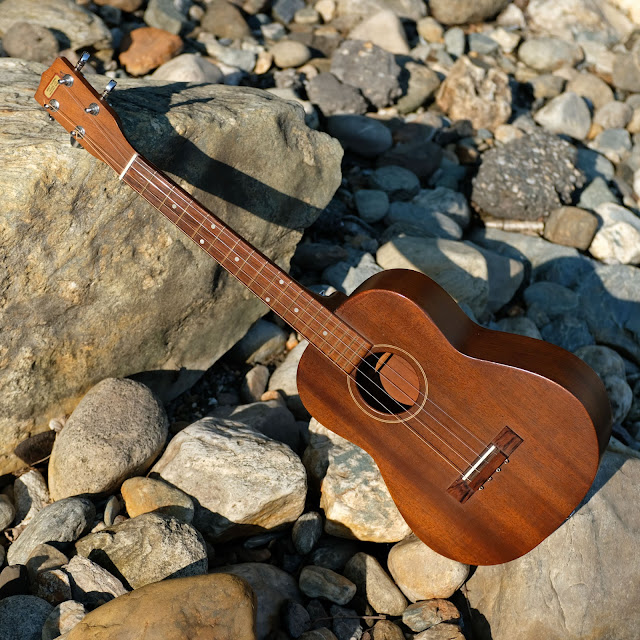1950s Vega-made Fandel Mini Tenor Guitar (Conversion)
Update: I made a few changes to the instrument so I've updated the description, images, and video/soundclip.
I found this Vega-made Fandel baritone uke (it's often hard to find anything vintage baritone outside of Harmony and Favillas unless you go upmarket) at a shop in New Hampshire and they popped it over to me on-the-quick. From my experience, this style of Vega bari tends to be a bit overbuilt and sounds a little stuffy compared to the slightly-earlier, fan-braced Vegas. The necks are also pretty tough and sturdy. These two details meant it was a perfect convert to very-light steel (I've done this same conversion before with a 2-year track record of stability), so that's what I did -- made it a mini tenor guitar and strung it in standard tenor-guitar CGDA (it's tuned-up to DAEB in the clip). It could easily retune to DGBE with thicker plain strings, too.
Gauges are 30w, 20w, 13, 9 low-to-high, so the tension difference between these and regular baritone uke strings is actually pretty minor, though I did need to compensate the new saddle for this stringing. I really like it tuned a step up from normal CGDA, though CGDA would probably sound better with gauges just slightly heavier -- 32w, 22w, 14, 10.
Work included a fret level/dress, new bone nut and saddle, an install of a set of parts-bin Grover tuners, hairline crack repair on the lower bout below the bridge (almost invisible), one brace reglue, and a setup. It plays spot-on and has a sweet, chimey, mellow tone. Volume is pretty good for its size and the mahogany-top voicing gives it a sound very similar to something like a Martin 5-17T, though with maybe a little more midrange shimmer.
Specs are: 19" scale, 1 3/8" nut width, 1 1/16" string spacing at the nut, 1 3/4" spacing at the bridge, 1/16" action at the 12th fret with a straight neck, 10" lower bout width, 7 1/4" upper bout, and 3 3/16" side depth at the endblock. The body and neck are all solid mahogany and the board and bridge are rosewood. The dots in the board are pearl and the frets are brass. It's all-original save tuners, saddle, and nut and pretty clean except for a few finish-drip areas -- two on the upper-bout where the top meets the edge and a couple of touch-up marks on the back. The neck is dead straight and the frets have plenty of life to live.
Gauges are 30w, 20w, 13, 9 low-to-high, so the tension difference between these and regular baritone uke strings is actually pretty minor, though I did need to compensate the new saddle for this stringing. I really like it tuned a step up from normal CGDA, though CGDA would probably sound better with gauges just slightly heavier -- 32w, 22w, 14, 10.
Work included a fret level/dress, new bone nut and saddle, an install of a set of parts-bin Grover tuners, hairline crack repair on the lower bout below the bridge (almost invisible), one brace reglue, and a setup. It plays spot-on and has a sweet, chimey, mellow tone. Volume is pretty good for its size and the mahogany-top voicing gives it a sound very similar to something like a Martin 5-17T, though with maybe a little more midrange shimmer.
Specs are: 19" scale, 1 3/8" nut width, 1 1/16" string spacing at the nut, 1 3/4" spacing at the bridge, 1/16" action at the 12th fret with a straight neck, 10" lower bout width, 7 1/4" upper bout, and 3 3/16" side depth at the endblock. The body and neck are all solid mahogany and the board and bridge are rosewood. The dots in the board are pearl and the frets are brass. It's all-original save tuners, saddle, and nut and pretty clean except for a few finish-drip areas -- two on the upper-bout where the top meets the edge and a couple of touch-up marks on the back. The neck is dead straight and the frets have plenty of life to live.
Annoyingly, when I was changing the tuners, the original friction peg ferrules were stuck so tight that when they came out, the wood chipped at one of the tuner post holes. It's minor, though.
This instrument came with a strap button at the endblock, but I also added one at the heel, too.














Comments